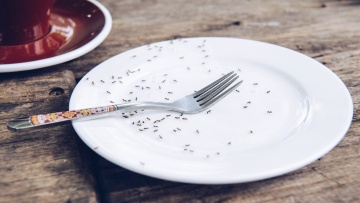Ants [Formicidae]
Ants can be a serious nuisance in homes, hospitality outlets and businesses. Their social organisation, diversity and adaptability have made them a priority for pest control specialists and homeowners alike.


Damages caused / challenges

A serious nuisance
The vast majority of ants live outdoors and perform a range of usual functions but problematic species attracted to human and pet foods with high sugar and protein contents typically cause pest problems.
When ants begin to infest homes and attack people in gardens and parks, they fall into the category of a nuisance pest. Some species can also be a public health problem and can short circuit electrical components enough to cause fires.
Highly successful insects
Ants owe much of their success to their advanced social structure. Clear divisions of labour between workers – scouts, foragers, larvae feeders and sentries, as well as between workers, queens and drones (reproductive males) make for highly efficient colony establishment, development and survival.
Their success in communicating leads to the well-travelled ant trails between nest sites and their various food sources that characterise most infestations. Trails become more persistent and difficult to disrupt with increasing use.
Profile
| Scientific name | Formicidae |
| Appearance | Workers measure 1,5-5 mm (depending on the species) |
| Diversity | 10,000-plus ant species known to exist, approximately 180 identified in Europe Species commonly found in Europe include: Black garden ant (Lasius niger) Yellow ant (Lasius flavus) Pavement ant (Tetramorium caepsitum) Carpenter ant (Campanotus sp.) Pharaoh ant (Monomorium pharaonis) Argentine ant (Linepithema humile) |
| Reproduction and life cycle | Once the colony is established, queens lay continuously Average colony size for the black garden ant is around 4,000-7,000 ants, other species can create meta colonies with 300.000 individuals |
| Diet | Sugar- and protein-rich food for problem species such as black garden, yellow and pavement ants |
| Social organisation | Foragers hunt out new food sources within up to 90 meters of the nest (depending on the species) and scouts lay down pheromones followed by foragers. Foraging workers then continuously carry food back to the colony , depending on species. As well as consuming it themselves, they share the food with all the non-foraging adults and developing larvae in a process known as trophallaxis. |
How to control
Pest control professionals need to follow several essential steps in order to efficiently control ants.
Establishing the extent and location of the infestation
A thorough inspection of the premises in dry weather is required to identify the level of infestation, species of ant (where possible), main trails and access points.
External ant trails need to be traced back as close to the nest as feasible, bearing in mind that trails may be very difficult to locate when conditions are wet.
Control strategy
Effective control of social insects like ants can only be achieved through measures which eliminate both the queens and their broods. Exclusion of foraging workers from food sources or their elimination – either physically or by chemical treatment – is rarely, if ever, sufficient to give more than temporary respite from most infestations.
Although generally ineffective on their own, physical means of excluding ants from buildings or food sources are cruical alongside chemical controls. This is especially noticeable in guarding against re-infestation from new colonies around sensitive locations.
Physical controls

The most effective measures include:
- Ant-proof storage of foods in truly sealable containers
- Regular cleaning of floors and surfaces to remove spillages and scent trails
- Proper disposal of kitchen scraps and food waste
- Permanent sealing of access points
Treatment programme
The only reliable way of ensuring complete control is to provide foraging workers with an attractive, powerful and readily-accessible insecticide bait which they both consume themselves and distribute throughout their colonies. The colony is controlled when the queen dies.
For the greatest effectiveness and reliability, the ant bait needs to be based on an insecticide which is:
- Undetectable to all ants yet powerful enough to be lethal when ingested or physically transferred within the colony in minimal amounts
- Sufficiently delayed in its action to allow foraging workers to distribute it widely to all adults and larvae within the colony before succumbing
The bait formulation must further be:
- Highly attractive and appealing to ants to stimulate the greatest possible worker feeding
- In liquid or gel form, to ensure rapid and effective active ingredient uptake and redistribution throughout the colony


